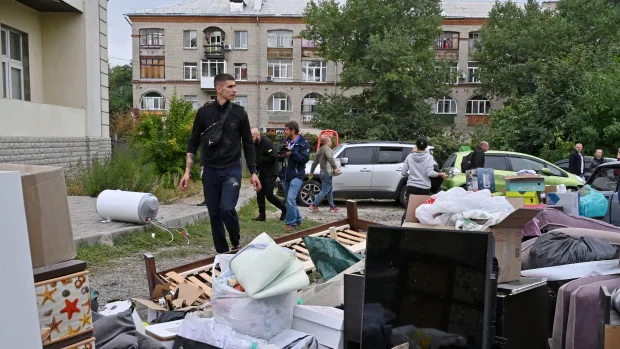Ukrainian troops continued to pile unrelenting pressure on retreating Russian forces on Tuesday, seeking to hold on to their sudden momentum that has produced major territorial gains.
Fresh yellow-and-blue flags fluttered from the tallest buildings left in partly destroyed towns around Ukraine’s second city, Kharkiv, while Ukrainian soldiers inspected charred Russian tanks left along the way.
“From the beginning of September until today, our soldiers have already liberated more than 6,000 square kilometres of the territory of Ukraine — in the east and south. The movement of our troops continues,” said Ukrainian President Volodymyr Zelenskyy in his nightly address late Monday.
Many of the claims of military success could not be independently verified.
British intelligence said that one of Moscow’s premier forces, the 1st Guards Tank Army, had been “severely degraded” during the invasion and that “Russia’s conventional force designed to counter NATO is severely weakened. It will likely take years for Russia to rebuild this capability.”
WATCH | ‘I wish it had taken me, not my kid’:
Susan Ormiston speaks with the family of an eight-year-old boy killed by shelling in southern Ukraine, leaving them devastated. His story paints a picture of the grief many families in Ukraine are grappling with as war continues to rage around them.
Fighting was still raging in the northeastern Kharkiv region, Deputy Defence Minister Hanna Malyar told Reuters on Tuesday, saying Ukraine’s forces were making good progress because they are highly motivated and their operation is well-planned.
“The aim is to liberate the Kharkiv region and beyond — all the territories occupied by the Russian Federation,” she said on the road to Balakliia, a crucial military supply hub recaptured by Ukrainian forces late last week that lies 75 kilometres southeast of Kharkiv, Ukraine’s second-largest city.
At least 3 killed in Russian shelling
The retreat didn’t stop Russia from pounding Ukrainian positions, however. Early Tuesday, it shelled the city of Lozova in the Kharkiv region, killing three people and injuring nine, said regional Gov. Oleh Syniehubov.
The Nikopol area, which is across the Dnieper River from the Zaporizhzhia nuclear power plant, was shelled six times during the night but no injuries were immediately reported, said regional Gov. Valentyn Reznichenko. Continued shelling has left Europe’s largest nuclear facility in a precarious position.
WATCH | Morale boost for Ukraine troops:
Zelenskyy specifically criticized Russia for targeting energy infrastructure in its attacks over the past days.
“Hundreds and thousands of Ukrainians found themselves in the dark — without electricity. Houses, hospitals, schools, communal infrastructure sites that have absolutely nothing to do with the infrastructure of the armed forces of our country,” he said.
“This is a sign of the desperation of those who contrived this war.”
The counteroffensive left the Kremlin struggling for a response to its largest military defeat in Ukraine since Russian forces pulled back from areas near Kyiv after a botched attempt to capture the capital early in the invasion.
The Russian Defence Ministry acknowledged the setback in a map that showed its troops pressed back along a narrow patch of land on the border with Russia — a tacit admission of big Ukrainian gains.
It was not yet clear if the Ukrainian blitz could signal a turning point in the war.
Western weapons ‘making the difference’
Some in Russia blamed Western weapons and fighters for the recent losses.
“It’s not Ukraine that attacked Izium, but NATO,” read a headline in the state-supported Komsomolskaya Pravda newspaper, referring to one of the areas where Russia said it has withdrawn troops.
WATCH | Russian soldier who defected after Kherson operation speaks to CBC News:
Former Russian soldier, Pavel Filatyev, says Russian troops were being misled about why they were in Ukraine and describes a chaotic scene on the front lines. He is now speaking out against the military he was a part of.
Precision weapons and rocket systems that the U.S. and Western nations have provided to Ukraine are seen as key to the dramatic shift in momentum. They include the precision-guided High-Mobility Artillery Rocket System, or HIMARS, and the High-speed Anti-Radiation Missile, or HARM, which is designed to target and destroy radar-equipped air defence systems.
“They’re there, they’re in theatre, and they’re making the difference,” said Delaware Democratic Sen. Chris Coons, a member of the U.S. Senate’s foreign relations committee.
Although there was widespread celebration of Ukraine’s gains over the weekend, U.S. officials know Russian President Vladimir Putin still has troops and resources to tap, and his forces still control large swaths of the east and south.
Philip Breedlove, retired U.S. air force general who was NATO’s top commander from 2013 to 2016, said Ukraine’s gains in the north and east could be “durable,” but he cautioned “there should be no spiking of the ball because Russia still has cards it can play.”

In fact, Ukraine’s military claimed Tuesday for the first time that it encountered an Iranian-supplied suicide drone used by Russia on the battlefield. U.S. intelligence publicly warned back in July that Tehran planned to send hundreds of the bomb-carrying drones to Russia.
A Ukrainian military official, as well as a pro-Ukrainian army website closely associated with the military, published images of the wreckage of the drone. It resembled a triangle, or delta-shaped, drone flown by Iran known as the Shahed.
The military official and the website both said Ukrainian troops encountered the drone near Kupiansk amid Kyiv’s offensive that has punched through Russian lines around Kharkiv on the eastern front. The image suggested the Shahed drone had been shot down by Ukrainian forces and hadn’t detonated on impact as designed, though little other information was immediately released by Kyiv.



